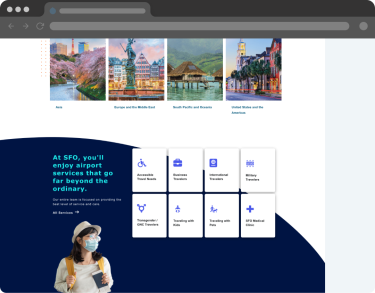
San Francisco International Airport
Acquia DAM (Widen), including the Assets, Insights, and Portals applications

increase in downloads
increase in users
The Client
San Francisco International Airport (SFO) is the second-busiest airport in California and the seventh busiest in the U.S.
The Situation
The San Francisco International Airport (SFO) put the digital asset management (DAM) platform Acquia DAM in place to store and organize all of its marketing assets, from creative files to employee photos. When deploying Acquia DAM, the SFO team created a metadata structure and assembled a team of interns to upload assets.
The Challenge
SFO didn’t have a governance policy, archival strategy, or a designated site administrator for its DAM system. Additionally, uploaders lacked the institutional knowledge needed to create meaningful metadata, leading to inconsistent or incomplete metadata values. As a result, SFO’s DAM system was so ineffective that employees barely used it.
The Solution
After suffering from an inefficient, ineffective DAM system for six years, SFO set out to overhaul its entire DAM site, turning an underutilized platform into an essential tool across its organization and beyond.
SFO’s Brand Manager Robin Brown understood that overhauling SFO’s DAM system would be no small feat. “I am a graphic designer and a brand manager, and had no experience managing a digital library,” she shared. “But I love a challenge, and overhauling SFO’s media library was a big one.”

“At that time, our digital media was all over the DAM place,” Brown explained. Some assets were in Acquia DAM but had erratic metadata, while others were scattered across shared drives, private drives, and camera memory drives. “We assembled a team to excavate and rebuild,” Brown said. She and her team executed their overhaul plan one step at a time.
Leverage resources
Brown and her team kicked off the overhaul project by gathering DAM resources — including blogs, training videos, and other support resources — to help them find their way and reach their goals.
Solicit internal feedback
SFO then gathered user feedback to ensure the DAM system was designed to support various workflows. “We had meetings and focus groups, and after surveying users and stakeholders, we came up with a strategy,” Brown shared.
Create a governance plan
Understanding that governance was another area that needed attention, Brown and her team developed a governance document that outlined why the DAM system exists and controls how it’s managed and used. This guiding information creates consistency across DAM processes now and into the future. Brown and her team refer to this document as “the DAM Bible.”
Update the metadata schema
Brown’s team also evaluated the existing metadata structure, updating it to include new fields and terminology. User feedback helped identify preferred search terms, which Brown’s team used to inform the DAM system’s metadata fields and controlled vocabulary.
Conduct a content audit
Brown and her team performed a systematic review of content in the existing DAM system, identifying content that was outdated, off-brand, or simply no longer needed. “We moved 20,000 untagged assets to an archival asset group to give us a clean slate. Then, we began the process of retagging the assets we wanted to keep and trashing the assets we no longer needed,” she said.
Apply the brand
Branding a DAM site as part of the organization helps ensure users connect to, engage with, and keep using the system. Brown applied the SFO visual identity to the login page and dashboard. “We now have a new login page with iconic SFO images and SFO branding. And I created a ‘DAM good’ dashboard with a new message and custom graphics that highlight spotlight collections and brand assets. The new look completely changed the impression you get when you log in. This one change had the biggest impact on how we were perceived,” Brown shared.
Enhance the user experience
To streamline the user experience, Brown and her team updated two functional components of the site. The first was adding single sign-on (SSO). “We added SSO through our company site to make it easier for employees to get to our DAM. Team members who previously could not find us can now access images and video quickly and painlessly,” she said.
The second change was updating conversion formats — which are options for changing the file type when assets are downloaded or shared. “We revamped conversion formats — less and easier to understand,” she said. Both updates made the platform easier to use.
Train users
In addition, Brown created training materials that are now part of SFO’s new employee onboarding process — everyone now knows where to go for visual assets. Training resources are housed in the DAM platform and available to anyone who has questions or needs a refresher on using the system.
Build ongoing awareness
Brown’s team realized that ongoing awareness-raising efforts were necessary for people to understand the value of the DAM system and use it. They found creative ways to keep the DAM top of mind with users. “We have instituted ‘upload Fridays’ as the day when new assets are uploaded, so our power users know when to look for new assets,” she said. SFO also promotes the DAM site on its intranet with success stories, scavenger hunts, and contests. As a result, internal login and download activity is on a steady upward trajectory.
Create a roadmap
Brown knew that any effective site overhaul strategy must include a plan for ongoing improvements. “We created a roadmap to steer us in the right direction and keep us focused. The admin team now meets regularly to brainstorm how we can keep SFO’s media library the only place to find and access SFO digital material,” she said.
The Results
After months of thoughtful and focused effort, the team’s hard work paid off. When SFO opened a new terminal, Harvey Milk Terminal 1, Brown shared that “for the first time, we were fully prepared to share assets with the media and marketing firms ahead of the opening.”
“We created a curated collection of photos and videos for media and international marketing partners. Instead of playing catchup and scrambling, we delivered a well-thought-out collection before the opening. Team members, stakeholders, and media had access to the photos and video they needed to showcase our new terminal,” she said.
Metrics showcase success
Metrics also show that the DAM overhaul was a success. The top ten most downloaded assets came from the collection curated for the opening, and general user activity is significantly higher than before the overhaul. “We had a 498% increase in downloads from July 2018 to 2019, and we increased users by 12%,” Brown explained.
As they look to the future, Brown and the team will continue to prioritize metadata applications as a big part of their strategy and will begin exploring the possibility of using Portals. But in the meantime, she and her team constantly receive positive feedback that stakeholders are able to find what they need from the DAM site. “Although the overhaul was a lot of hard work, it was worth it! It’s been a DAM interesting journey, and the ride’s not over yet!” she concluded.